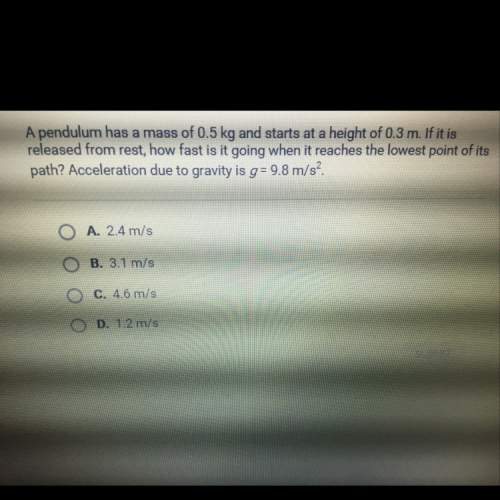
What do the atoms of elements in the same group have in common? a. they have the same atomic numbers. b. they have the same average atomic masses. c. they have the same number of electron shells. d. they have the same number of electrons in their outermost shells.

Answers: 1


Another question on Physics

Physics, 21.06.2019 21:00
A150 w lamp emits light of wavelength 590 nm uniformly in all directions. what is the photon flux (photons per unit area per unit time) on a small screen at a distance 2.3 m from the lamp? assume the photons are uniformly distributed over the surface of a sphere of radius 2.3 m.
Answers: 2

Physics, 21.06.2019 22:00
Jason and mia are both running in a race. as they approach the finish line, you being the physicist that you are decide to time how long it takes them to reach the end of the race. when you start your stop watch (you can take this as time t = 0 s) you notice that mia is an unknown distance d ahead of jason and both are moving with the same initial velocity v_0. you also notice that jason is accelerating at a constant rate of a_j, while mia is deaccelerating at a constant rate of -a_m. jason and mia meet each other for the first time at time t = t_1. at this time (t = t_1) jason's velocity is two times that of mia's velocity, meaning v_j (t_1) = 2v_m (t_1). a) draw the position vs. time graph describing mia's and jason's motion from time t = 0 to time t = t_1. clearly label your axes and initial conditions on your graph. b) draw the velocity vs. time graph describing mia and jason's motion from time t = 0s to time t = t_1. clearly label your axes and initial conditions on your graph. c) how long from when the stop watch was started at t = 0s did it take mia and jason to meet? express your answer in terms of know quantities v_0, a_m, and a_j. d) when the stop watch started at time t = 0s, how far apart, d, were mia and jason? express your answer in terms of know quantities v_0, a_m, and a_j.
Answers: 1

Physics, 22.06.2019 04:30
The pressure increases by 1.0 x 104 n/m^2 for every meter of depth beneath the surface of the ocean. at what depth does the volume of a pyrex (bulk modulus 2.6 x 1010n/m^2) glass cube, 9.8 x 10^−2m on an edge at the ocean's surface, decrease by 7.5 x 10−10m^3? explain the formula beyond this point: p=1.0x10^4, b=2.6x10^10, l=9.8x10^−2, delta v=7.5x10^−10. at some point l needs to be cubed. why p is divided by delta v?
Answers: 2

Physics, 22.06.2019 11:10
Which situation will produce the greatest change of momentum
Answers: 2
You know the right answer?
What do the atoms of elements in the same group have in common? a. they have the same atomic number...
Questions

Social Studies, 03.06.2021 21:40

Arts, 03.06.2021 21:40

Mathematics, 03.06.2021 21:40


Mathematics, 03.06.2021 21:40


Mathematics, 03.06.2021 21:40

Mathematics, 03.06.2021 21:50




Mathematics, 03.06.2021 21:50


Mathematics, 03.06.2021 21:50

Mathematics, 03.06.2021 21:50





History, 03.06.2021 21:50




